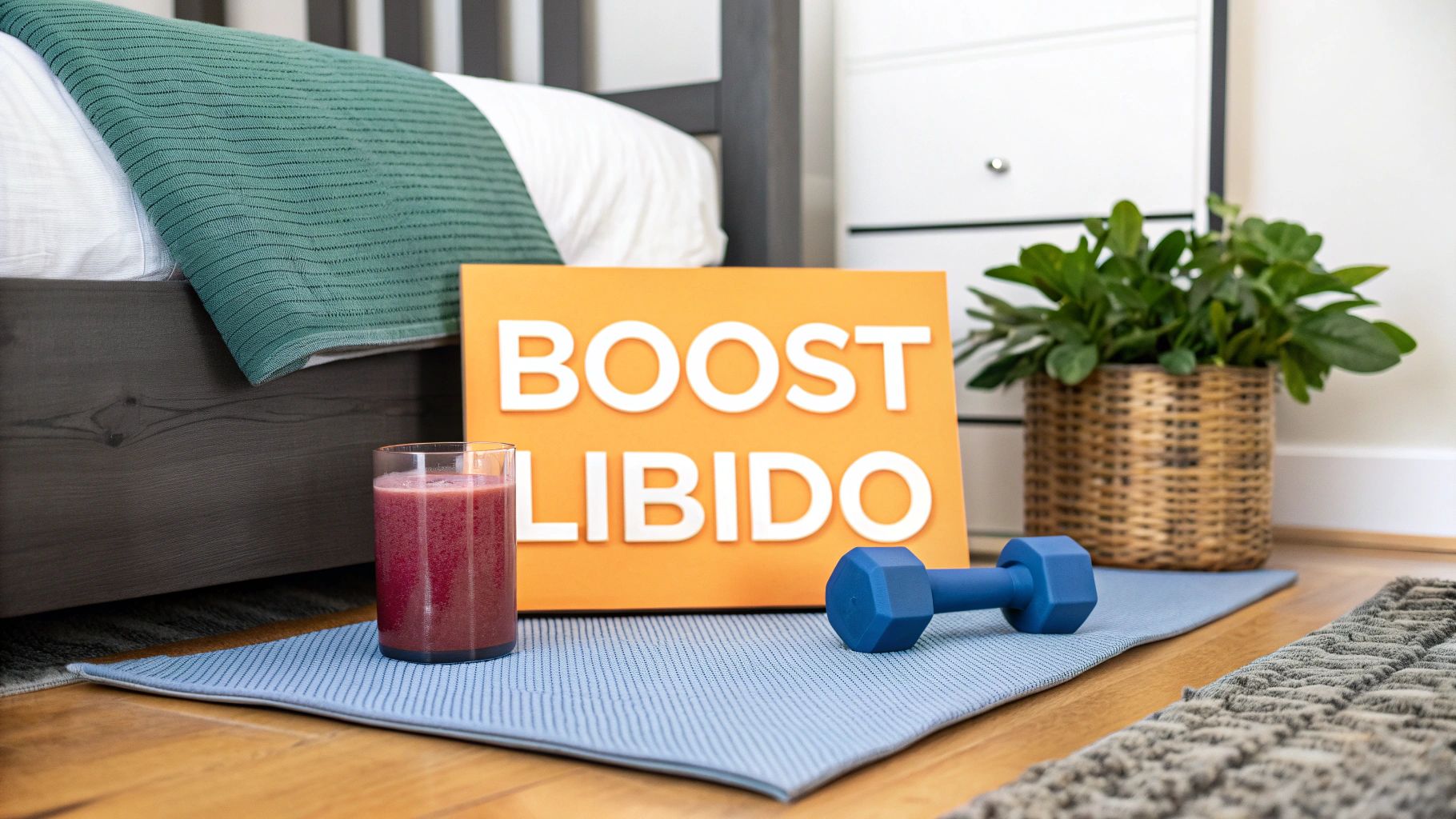Your Guide to Testosterone Injections at Home
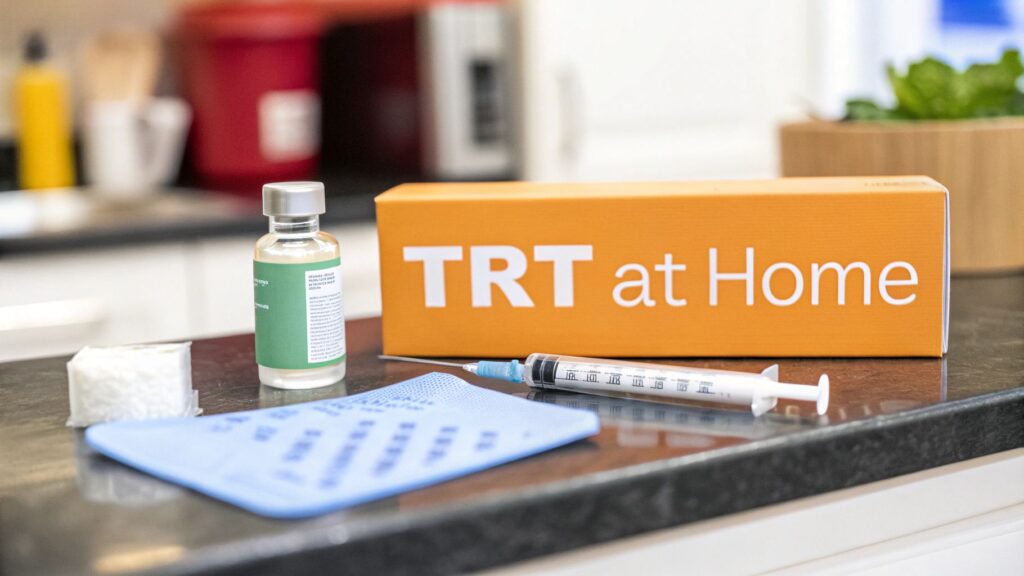
Doing your own testosterone injections at home might sound intimidating, but it's a completely safe and effective way to manage Testosterone Replacement Therapy (TRT) when you're under medical supervision. The truth is, it gives you a level of privacy, convenience, and control over your own treatment schedule that you just can't get with clinic visits. With the right guidance from your doctor, what seems like a complex medical task quickly becomes a simple, routine part of taking care of yourself.
Why At-Home Testosterone Injections Are Becoming Common

More and more guys are handling their TRT from home, and for good reason. The old-school model of trekking to a clinic every week for a shot just doesn't fit with most people's lives anymore. Performing testosterone injections at home gets rid of the need for those constant appointments, saving a ton of time and travel costs. It’s a shift that puts you firmly in the driver’s seat of your own health journey.
Even with other options like gels, patches, and pills on the market, injections are still the gold standard for TRT. Why? They give you predictable absorption and keep your hormone levels stable, which is what helps you feel your best. This method also dodges the skin absorption problems you can run into with gels and completely removes the risk of transferring it to a partner or family member.
The Rise of Self-Administered TRT
The move toward at-home TRT is part of a much bigger trend in healthcare. Over the last decade, Testosterone Replacement Therapy has exploded into a massive global market, and injectables are leading the charge. The global market for injectable testosterone was worth over USD 2.16 billion and is expected to hit USD 3.55 billion by 2037.
This guide is here to walk you through all the common worries and questions that pop up when you're thinking about injecting yourself. We get it—the idea can be a little nerve-wracking at first. But with the right knowledge and consistent guidance from your doctor, it’s a process you can absolutely master.
The benefits really speak for themselves:
- Ultimate Convenience: You give yourself your dose on your own time, without having to blow up your work or personal schedule.
- Enhanced Privacy: Managing your treatment in your own space gives you a level of discretion you’ll never get at a clinic.
- Potential Cost Savings: By cutting out all those clinic fees and co-pays, at-home injections can be way more affordable. For a full breakdown, check out our guide on the cost of TRT without insurance.
The goal is to build your confidence through education. By mastering the correct technique, you transform a clinical procedure into a routine act of self-care, giving you direct control over your well-being.
Throughout this guide, we'll zero in on the key things that make this work. That means setting yourself up for safety, nailing the proper technique, and—most importantly—keeping an open line of communication with your doctor. Their oversight is non-negotiable for fine-tuning your protocol and monitoring your health so you get the best results safely.
Setting Up for a Safe and Stress-Free Injection
Confidence is the first ingredient for successful at-home testosterone injections. The process starts long before the needle touches your skin; it begins with creating a clean, organized, and calm environment. This simple prep work turns what feels like an intimidating medical task into a simple, manageable routine.
Your first move? Gather all your supplies. Think of it as creating your personal TRT toolkit. Having everything laid out and ready to go eliminates any last-minute scrambling and helps quiet any pre-injection jitters. This one act of preparation immediately puts you in control.
Gathering Your Essential Supplies
Before every single injection, do a quick inventory check. Make sure everything you need is within arm's reach. This is critical because stopping mid-process to find something can break your sterile environment.
Your standard kit should always include:
- Testosterone Vial: The medication itself, prescribed by your doctor.
- Syringes and Needles: You’ll likely have two different needles—a larger gauge needle for drawing the testosterone from the vial and a smaller, thinner one for the actual injection.
- Alcohol Prep Pads: For sterilizing the vial's rubber stopper and the injection site on your skin.
- A Puncture-Proof Sharps Container: This is an absolute must-have. Safe disposal of used needles and syringes is non-negotiable.
- Bandages: To cover the injection site when you're done.
To make things even easier, you can explore options for how to get prescriptions delivered, which often includes a complete kit with all the necessary supplies sent right to your home.
This infographic breaks down the simple workflow for getting your injection station ready.
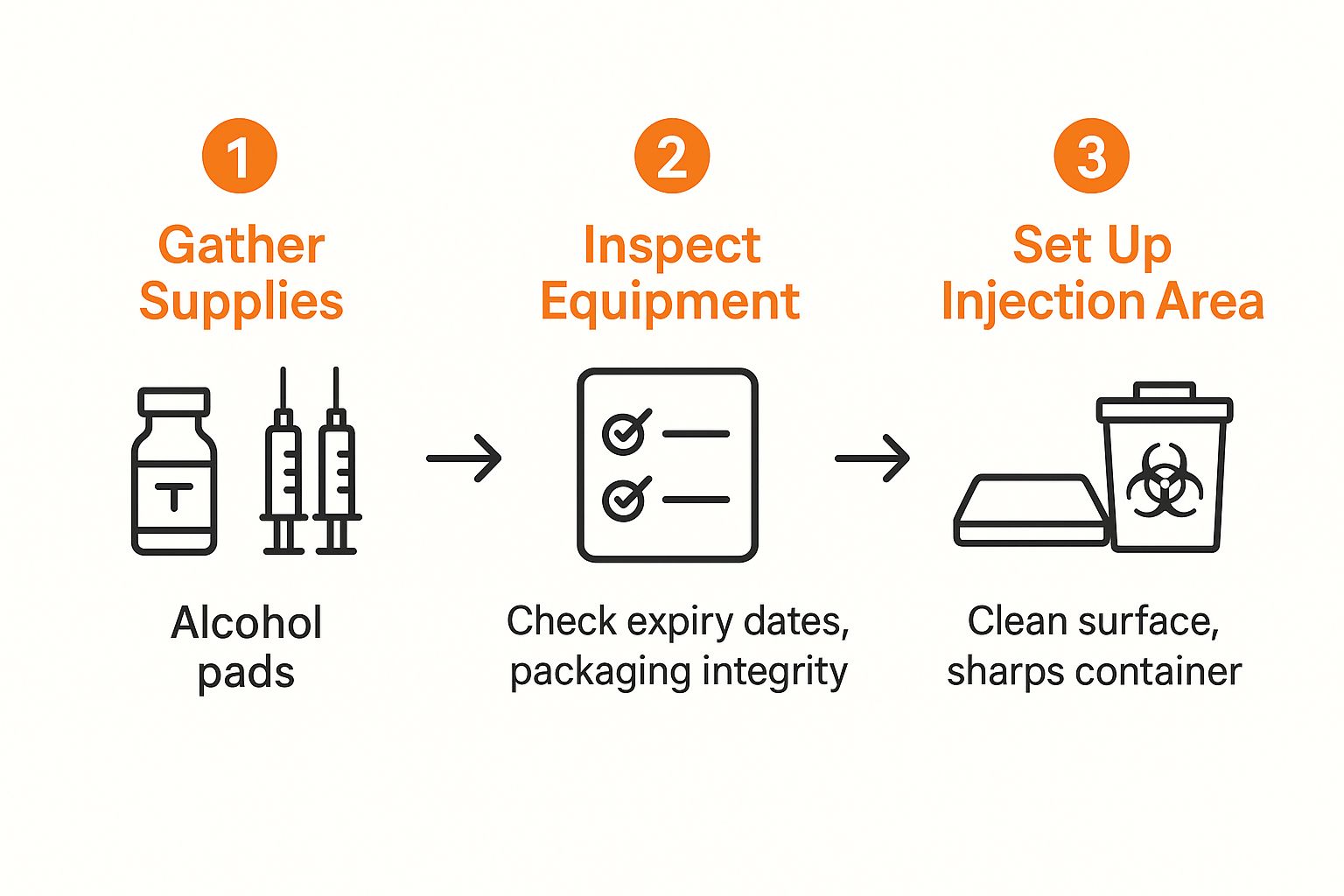
As you can see, a safe injection is built on a foundation of careful preparation and inspection before you even uncap a needle.
Creating Your Injection Ritual
Once your supplies are gathered, turn your focus to the environment. Designate a specific spot in your home for your injections, like a clean countertop in the bathroom or a dedicated corner of your desk. This space needs to be well-lit, uncluttered, and easy to sanitize.
Wipe the surface down with an antibacterial cleaner before you lay out your supplies. Consistency is your best friend here. Using the same spot every time helps build muscle memory, turning the process into a comfortable habit rather than a stressful event.
Your setup is more than just a checklist; it's a personal ritual. Taking a few moments to organize your space and inspect your equipment builds the confidence needed to perform testosterone injections at home safely and effectively.
Before you uncap anything, do a final safety check. Look at the testosterone vial—are there any floating particles or is the liquid discolored? Check the expiration dates on all your supplies, from the medication itself to the alcohol pads. Make sure all the packaging is sealed and intact.
If anything looks off or compromised, do not use it. Contact your pharmacy or doctor right away. This simple, two-minute check is your best defense against potential complications.
A Practical Walkthrough of the Injection Process
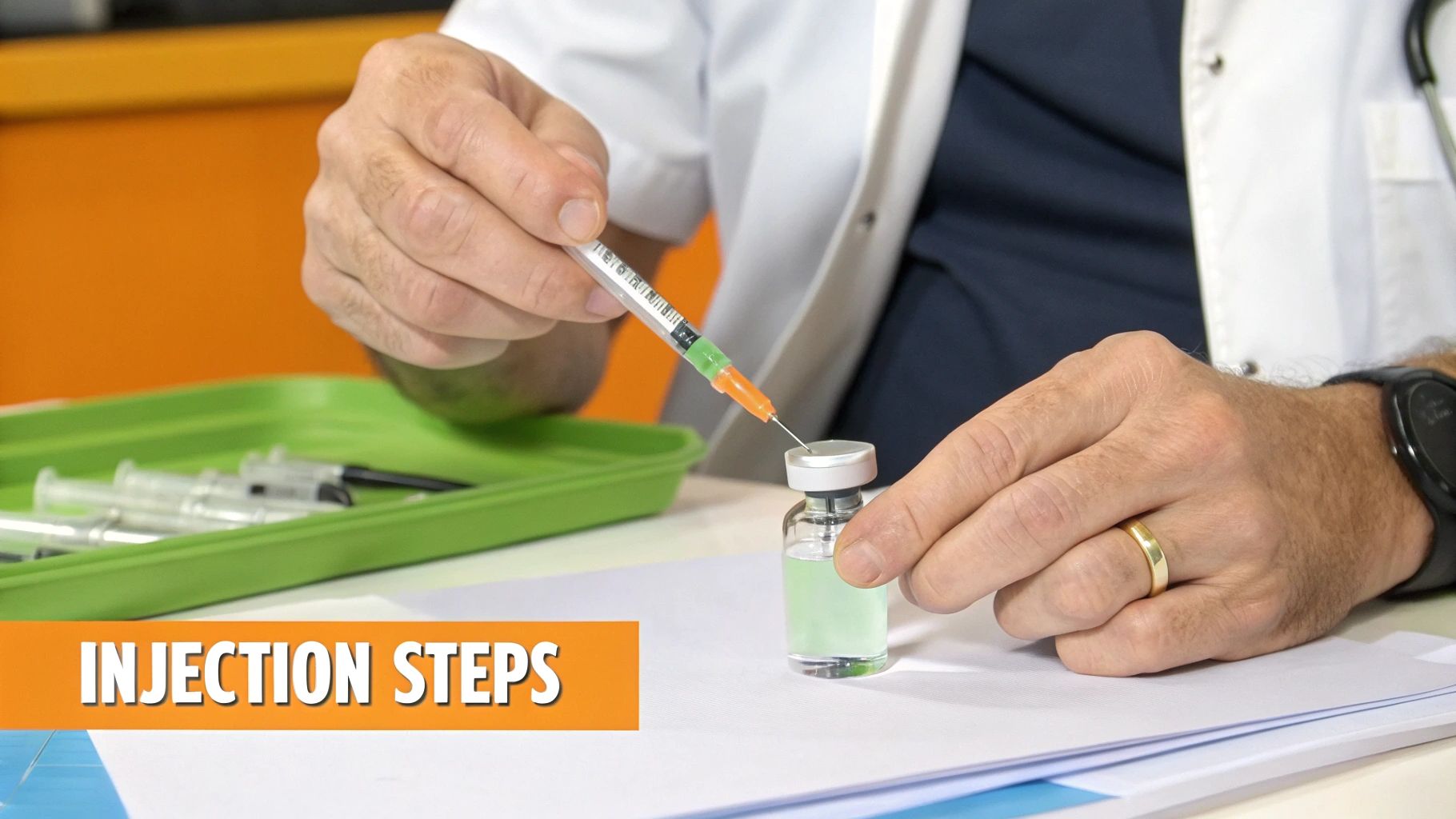
Alright, you've got your space prepped and your supplies laid out. Now it's time to focus on the technique itself. Don't think of this as just a clinical procedure; it's a skill you're going to build and refine over time. The real goal here is to make every step—from drawing your dose to putting on the final bandage—feel smooth, comfortable, and confident.
First things first, let's get the testosterone into the syringe. After giving your hands a thorough wash, grab an alcohol pad and give the rubber stopper on your testosterone vial a good, vigorous scrub for about 15 seconds. This simple step is your most important line of defense against infection, so don't skip it.
Next, get your syringe ready. If your dose is 0.5 mL, you’ll pull the plunger back to that same mark, filling the syringe with air. With the vial sitting flat, push the needle right through the center of the rubber stopper and inject all that air inside. This pressurizes the vial, which makes drawing out the thick, oil-based testosterone a whole lot easier.
Now, flip the vial and syringe upside down. Slowly pull the plunger back to draw a little bit more than your actual dose into the syringe. This is a neat trick to help you deal with any air bubbles that sneak in. Gently tap the side of the syringe to make the bubbles rise to the top, then slowly push the plunger until the top edge of the black seal lines up perfectly with your dose mark, pushing all the air out. You can now pull the needle out of the vial.
Intramuscular vs Subcutaneous Injections
Your doctor will tell you exactly which method to use, but it's helpful to understand the two main types of injections. The choice usually comes down to your dosage, the specific type of testosterone you're using, and what feels most comfortable for you.
| Injection Type | Description | Common Needle Size |
|---|---|---|
| Intramuscular (IM) | The needle goes deep into the muscle. This allows for quick absorption and is the traditional method for oil-based testosterone. | 22-25 gauge, 1 to 1.5 inches long |
| Subcutaneous (SubQ) | The needle goes into the fatty layer just under the skin. This method is often less painful and is great for smaller, frequent doses. | 25-30 gauge, 0.5 to 5/8 inches long |
For most guys doing their own testosterone shots at home, the glute or the thigh (the big muscle on the side, called the vastus lateralis) are the go-to spots for IM injections. For SubQ, the fatty tissue around the stomach or love handles works perfectly. The absolute key to long-term comfort is rotating your injection sites. This prevents soreness and stops scar tissue from building up.
Administering the Injection with Confidence
Once your dose is drawn and you've picked your spot, you're ready for the main event. Take a fresh alcohol pad and clean the skin, using a circular motion and moving from the inside out. Let the alcohol air dry completely. Trust me, waiting a few seconds makes a huge difference in reducing the sting.
Pro Tip: Never inject into an area that looks red, bruised, or has any kind of rash. Always pick a healthy patch of skin and be disciplined about rotating your sites every week to give the tissue plenty of time to heal.
For an intramuscular injection, hold the syringe like a dart at a 90-degree angle to your skin. In one smooth, confident motion, insert the needle all the way in. Inject the testosterone slowly and steadily. Taking about 10 seconds per 0.5 mL can dramatically reduce any post-injection pain.
For a subcutaneous injection, you'll gently pinch an inch or two of skin. Insert the needle at a 45-degree angle and slowly push the medication in. Releasing the pinch just before you pull the needle out can help the oil disperse better under the skin.
After the injection is done, pause for a second before smoothly pulling the needle out. Immediately apply gentle pressure with a clean cotton ball or gauze. A small bandage is usually all you’ll need. And finally, the most important safety step: never, ever try to recap the used needle. Drop it directly into your approved sharps container.
Understanding and Managing Potential Side Effects
Starting testosterone therapy is a big step toward getting your energy and vitality back. While the benefits are huge, it’s just as important to go in with your eyes open about potential side effects. This isn’t about scaring you off—it’s about empowering you to be an active, informed partner in your own treatment.
The good news is that most guys only deal with minor, temporary issues. The most common things you’ll see are reactions right at the injection site. A little bit of soreness, some redness, or even a small, firm lump under the skin are all pretty standard. This is just your body’s normal response to an oil-based solution, and it usually fades away in a day or two.
Knowing When to Worry and When to Relax
The key to doing this safely at home is learning to tell the difference between a normal reaction and a real warning sign. A bit of tenderness is one thing, but intense pain, swelling that starts to spread, skin that feels hot, or any kind of discharge from the site are not normal. Those are red flags for a possible infection, and you need to call your doctor right away.
For a more detailed breakdown of everything you might experience, our comprehensive guide on testosterone therapy side effects is a great resource.
Think of monitoring your body as a team effort between you and your doctor. Keeping the lines of communication open about anything new or concerning is the cornerstone of a safe and effective treatment plan.
This is exactly why your doctor will schedule regular blood work. These tests aren't just for checking your testosterone levels; they're essential for tracking other important markers like hematocrit (your red blood cell count) and PSA (prostate-specific antigen) to make sure your therapy stays safe and dialed in.
To help you sort through what you might be feeling after a shot, here’s a quick guide to distinguishing between common reactions and symptoms that need a doctor's attention.
Recognizing Common vs. Serious Side Effects
This table helps distinguish between normal post-injection reactions and symptoms that mean you should call your doctor.
| Symptom | What It Might Feel Like | When to Contact Your Doctor |
|---|---|---|
| Mild Soreness | A dull ache, similar to a flu shot, that lasts for a day or two. | If the pain is sharp, severe, or makes it hard to move the muscle. |
| Redness or Itching | A small, localized pink or red area around the injection site. | If the redness spreads significantly, is accompanied by heat, or a rash develops. |
| Small Lump (Nodule) | A small, firm, pea-sized lump under the skin that slowly disappears. | If the lump is very large, painful, hot to the touch, or leaking fluid. |
| Minor Bruising | A small, discolored spot where the needle went in. | If bruising is extensive, spreads, or is accompanied by severe swelling. |
| Systemic Symptoms | You feel completely fine otherwise, with no fever, chills, or body aches. | If you develop a fever, chills, body aches, or feel generally unwell. |
This table should give you a good baseline for what's normal. Your body is adjusting, but anything that feels "off" or severe is always worth a phone call to your healthcare provider.
Acknowledging the Broader Health Picture
It’s also smart to be aware of how different TRT methods stack up. While injections are incredibly effective, they come with their own set of considerations, especially when compared to other delivery systems like gels.
One large-scale U.S. study looked at over 544,000 men who were just starting TRT. The findings were pretty significant. Compared to men using gels, those who started with injections had a 26% higher risk of cardiovascular events, a 16% higher risk of hospitalization, and a 34% higher risk of death.
These numbers aren't meant to be alarming, but they do highlight just how critical it is to have ongoing medical supervision and to work with your doctor to choose the TRT method that best fits your individual health profile.
Proper Aftercare and Safe Needle Disposal
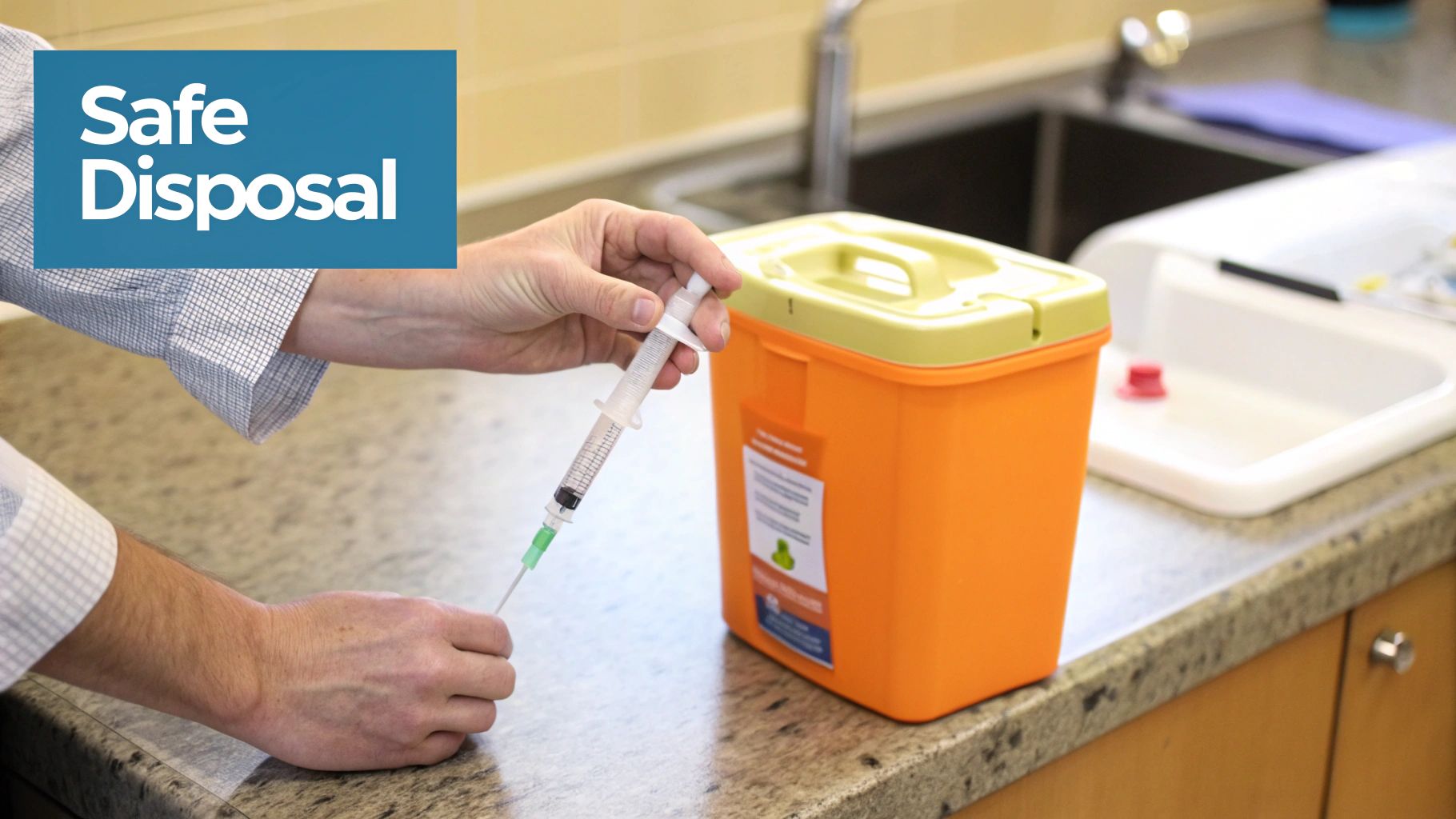
Alright, you've completed the injection. But the job isn't quite done yet. What you do in the minutes and hours afterward is just as important for your comfort and for the safety of everyone in your home. Let's walk through the final steps.
It's very common to feel a bit of soreness or even find a small, firm lump under the skin right after an injection. Don't panic—this is a normal reaction, especially with oil-based medications like testosterone. The oil just needs a little help dispersing into the muscle.
A simple warm compress applied to the area for about 10-15 minutes can make a world of difference. The warmth helps soothe the muscle and encourages the oil to spread out, which can relieve that tender feeling.
You can also try gently massaging the muscle around the injection site, but be careful not to put direct, heavy pressure right on the injection point itself. These small aftercare habits can significantly reduce any lingering tenderness.
The Non-Negotiable Step: Safe Disposal
This part is not optional. Used needles and syringes are medical waste, and they absolutely cannot be tossed into your regular kitchen trash. This is a critical safety rule to prevent accidental needlestick injuries, which can transmit serious infections.
Your injection kit must include an FDA-cleared sharps disposal container. These are tough, puncture-proof plastic containers designed specifically for this purpose.
Disposing of your needles correctly is a fundamental responsibility of at-home medical care. It protects your family, sanitation workers, and your community from preventable harm.
Once you’ve administered the injection, here’s exactly what to do with the used needle and syringe:
- Do Not Recap: Seriously, never try to put the cap back on a used needle. This is how the vast majority of accidental sticks happen. Just don't do it.
- Dispose Immediately: As soon as the needle is out of your skin, it goes directly into the sharps container. No setting it down on the counter first.
- Secure the Container: When your sharps container is about three-quarters full, it’s time to seal it up for good, following the manufacturer's instructions.
You can typically get a sharps container from your pharmacy, a medical supply company, or through your doctor's office. When it's full, you'll need to know your local disposal options. Many communities have specific programs, like drop-off sites at hospitals, fire stations, or designated waste facilities. A quick call to your local health department will tell you exactly where you can safely dispose of it in your area.
Common Questions About Home Testosterone Injections
When you first start doing your own testosterone injections at home, it's totally normal for a few questions to pop up. Knowing what to do in common situations ahead of time can help you handle them calmly and correctly, keeping your treatment on track and stress-free. Let's tackle some of the most frequent concerns.
What Should I Do If I Miss a Dose?
Life happens. At some point, you're probably going to forget an injection. The number one rule here is simple: never double up on your next dose to try and "catch up." Shoving a double dose into your system can throw your hormone levels way out of whack and crank up the risk of side effects.
If you miss a dose, the best thing to do is just contact your doctor for advice. Their guidance is gold because the right answer really depends on your specific protocol. Most of the time, if it's only been a day or two since you were supposed to inject, they’ll probably tell you to take it and then get back on your normal schedule. But if you’re already pretty close to your next planned dose, they might just tell you to skip the missed one entirely.
Is It Normal to Have a Small Lump or Soreness?
Yes, a little bit of soreness, some redness, or even a small, firm lump right at the injection site is very common. This is especially true with oil-based solutions like testosterone. It's usually just a local reaction as your body slowly works on absorbing the medication.
To keep this to a minimum, try these simple tricks:
- Rotate Your Injection Sites: Don't hit the same spot every time. Give that tissue a chance to heal and recover.
- Inject Slowly: A slow, steady pressure on the plunger allows the oil to disperse more gently into the muscle or subcutaneous tissue. It makes a big difference.
- Apply a Warm Compress: A little bit of warmth after the shot can really help soothe the area and encourage absorption.
A small, tender nodule is usually nothing to worry about. However, you need to contact your doctor right away if the lump becomes very painful, feels hot to the touch, has any drainage, or if you start running a fever. Those could be signs of an infection.
Can I Travel with My TRT Supplies?
Absolutely, but a little prep work is key to making sure it all goes smoothly. When you're traveling, always keep your testosterone and supplies in their original packaging with the pharmacy label clearly visible. It's also a really smart move to carry a letter from your doctor that explains why you medically need the medication and syringes.
When you fly, always pack your TRT supplies in your carry-on luggage. Never put them in a checked bag. Checked luggage can be exposed to extreme temperatures that can ruin the medication, not to mention the risk of it getting lost. If you're heading overseas, make sure you research the specific regulations for your destination country well in advance, as the rules can vary a lot. A little planning means your therapy continues uninterrupted, no matter where your travels take you.
Ready to take control of your health with a plan designed just for you? At Elite Bioscience, we make it simple to get the high-quality, doctor-prescribed therapies you need, delivered discreetly to your door. Explore our personalized treatment options and start your journey today at https://elitebioscience.co.
QUICK SEARCH
Make an account today to start your journey towards a better and healthier lifestyle.






